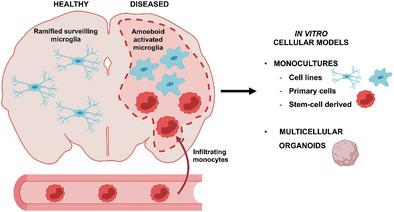当前位置:
X-MOL 学术
›
J. Leukoc. Biol.
›
论文详情
Our official English website, www.x-mol.net, welcomes your feedback! (Note: you will need to create a separate account there.)
Functional consequences of a close encounter between microglia and brain-infiltrating monocytes during CNS pathology and repair
Journal of Leukocyte Biology ( IF 5.5 ) Pub Date : 2020-11-06 , DOI: 10.1002/jlb.3ru0820-536r Alessandra Quarta 1 , Zwi Berneman 1 , Peter Ponsaerts 1
Journal of Leukocyte Biology ( IF 5.5 ) Pub Date : 2020-11-06 , DOI: 10.1002/jlb.3ru0820-536r Alessandra Quarta 1 , Zwi Berneman 1 , Peter Ponsaerts 1
Affiliation

|
Neuroinflammation is recognized as an important factor contributing to the development and progression of several central nervous system (CNS) disorders. Upon CNS trauma or disease, parenchymal microglia highly proliferate and accumulate in and around the lesion site. In addition, blood-derived monocytes can infiltrate the inflamed CNS in response to cellular damage and/or a compromised blood–brain barrier. Both microglia and infiltrating monocytes are characterized by multiple functional states and can either display highly proinflammatory properties or promote resolution of inflammation and tissue regeneration. Despite sharing some basic immunologic functions, microglia and monocytes display many distinctive features, which ultimately define their contribution to neuropathology. Understanding how the innate immune system participates to brain disease is imperative to identify novel treatment options for CNS inflammatory disorders. In this context, existing and newly developed in vitro platforms for disease modeling are fundamental tools to investigate and modulate microglia and monocyte immune functions within a specific neuropathologic context. In this review, we first briefly summarize the current knowledge on microglia and monocyte ontogenesis, as well as their complex and interconnected contributions to the development of various CNS pathologies. Following the well-recognized concept that both microglia and monocytes can either exert neuroprotective functions or exacerbate tissue damage, we provide a comprehensive overview of cellular models currently available for in vitro study of neuroinflammatory responses. In this context, we highlight how simplified single-cell models may not always correctly recapitulate in vivo biology, hence future research should move toward novel models with higher and multicellular complexity.
中文翻译:

中枢神经系统病理和修复过程中小胶质细胞和脑浸润单核细胞近距离接触的功能后果
神经炎症被认为是导致几种中枢神经系统 (CNS) 疾病发展和进展的重要因素。在中枢神经系统创伤或疾病后,实质小胶质细胞高度增殖并在病变部位及其周围积聚。此外,血液来源的单核细胞可因细胞损伤和/或血脑屏障受损而渗入发炎的中枢神经系统。小胶质细胞和浸润性单核细胞都具有多种功能状态,可以表现出高度促炎特性或促进炎症消退和组织再生。尽管共享一些基本的免疫功能,小胶质细胞和单核细胞显示出许多独特的特征,最终定义了它们对神经病理学的贡献。了解先天免疫系统如何参与脑部疾病对于确定 CNS 炎症性疾病的新治疗方案至关重要。在此背景下,现有的和新开发的用于疾病建模的体外平台是在特定神经病理学背景下研究和调节小胶质细胞和单核细胞免疫功能的基本工具。在这篇综述中,我们首先简要总结了小胶质细胞和单核细胞个体发生的当前知识,以及它们对各种 CNS 病理学发展的复杂和相互关联的贡献。遵循公认的概念,即小胶质细胞和单核细胞都可以发挥神经保护功能或加剧组织损伤,我们全面概述了目前可用于体外神经炎症反应研究的细胞模型。在这种情况下,我们强调了简化的单细胞模型可能并不总是在体内正确概括 生物学,因此未来的研究应该转向具有更高和多细胞复杂性的新模型。
更新日期:2020-11-06
中文翻译:

中枢神经系统病理和修复过程中小胶质细胞和脑浸润单核细胞近距离接触的功能后果
神经炎症被认为是导致几种中枢神经系统 (CNS) 疾病发展和进展的重要因素。在中枢神经系统创伤或疾病后,实质小胶质细胞高度增殖并在病变部位及其周围积聚。此外,血液来源的单核细胞可因细胞损伤和/或血脑屏障受损而渗入发炎的中枢神经系统。小胶质细胞和浸润性单核细胞都具有多种功能状态,可以表现出高度促炎特性或促进炎症消退和组织再生。尽管共享一些基本的免疫功能,小胶质细胞和单核细胞显示出许多独特的特征,最终定义了它们对神经病理学的贡献。了解先天免疫系统如何参与脑部疾病对于确定 CNS 炎症性疾病的新治疗方案至关重要。在此背景下,现有的和新开发的用于疾病建模的体外平台是在特定神经病理学背景下研究和调节小胶质细胞和单核细胞免疫功能的基本工具。在这篇综述中,我们首先简要总结了小胶质细胞和单核细胞个体发生的当前知识,以及它们对各种 CNS 病理学发展的复杂和相互关联的贡献。遵循公认的概念,即小胶质细胞和单核细胞都可以发挥神经保护功能或加剧组织损伤,我们全面概述了目前可用于体外神经炎症反应研究的细胞模型。在这种情况下,我们强调了简化的单细胞模型可能并不总是在体内正确概括 生物学,因此未来的研究应该转向具有更高和多细胞复杂性的新模型。



























 京公网安备 11010802027423号
京公网安备 11010802027423号